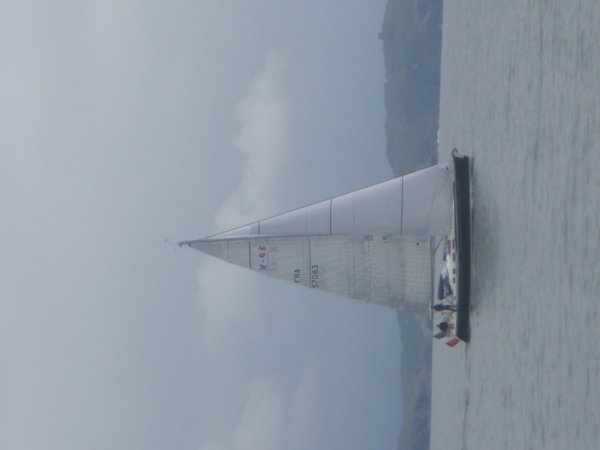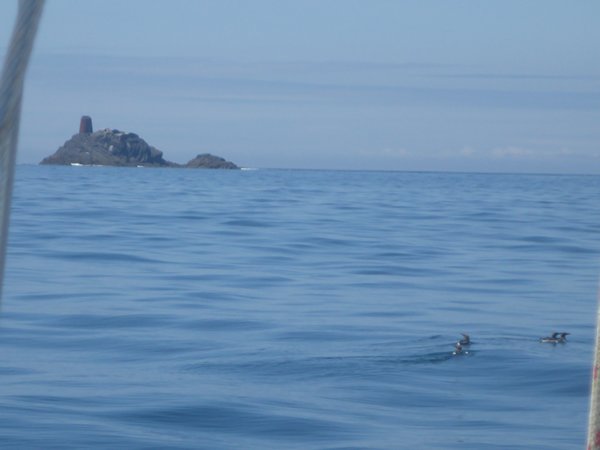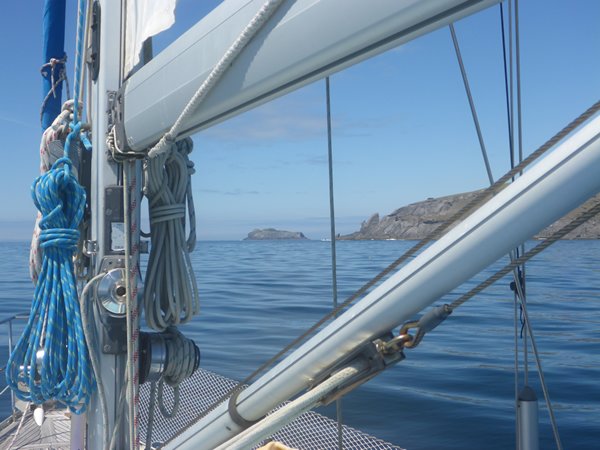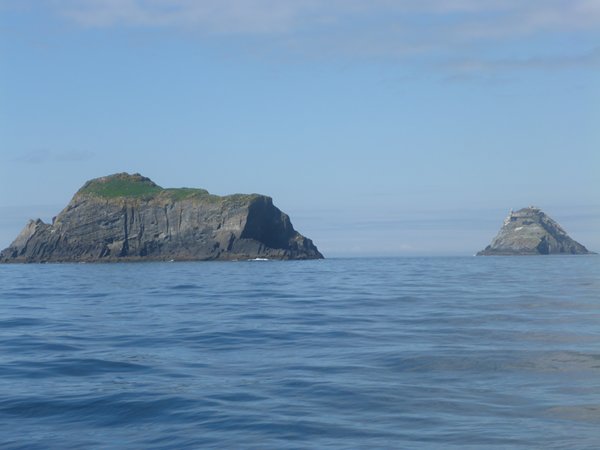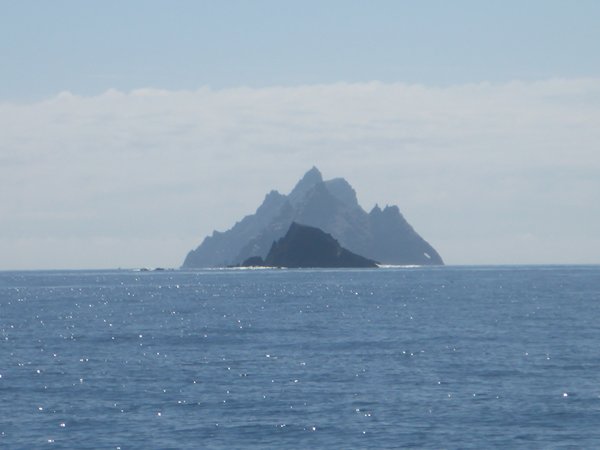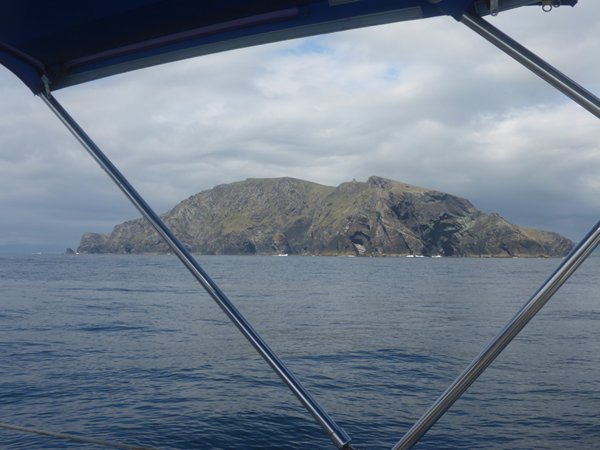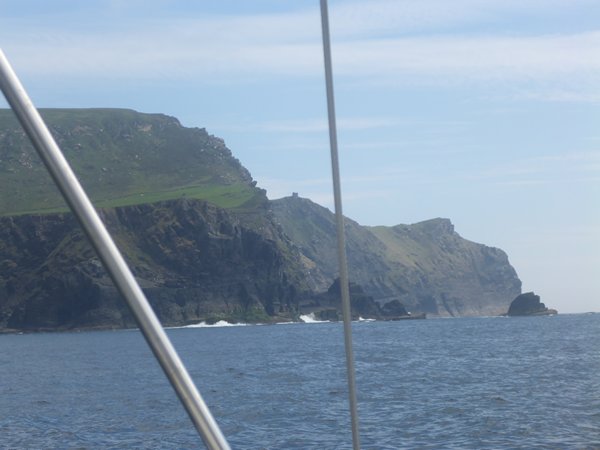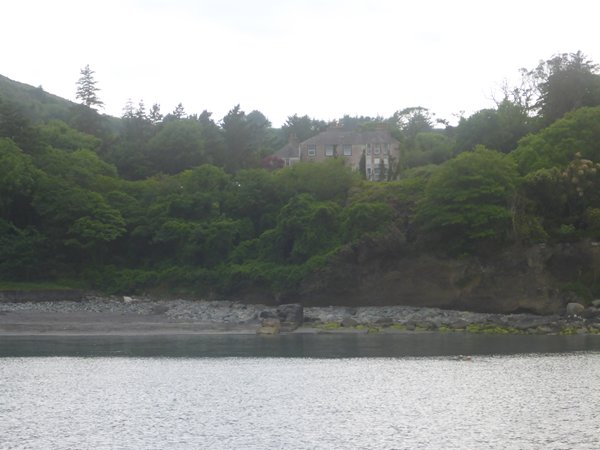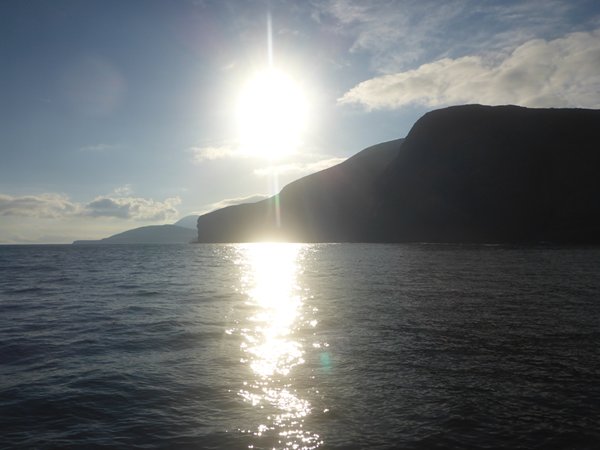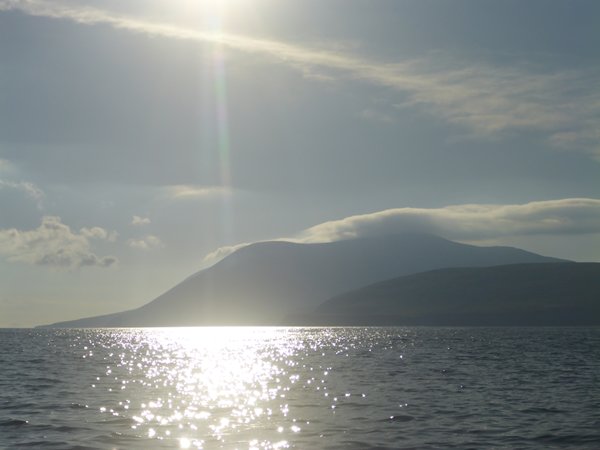Glanleam Bay

51:55.51N 10:18.91W
Escaping from under the Gloom to Glanleam Bay
Valentia Island
Zoonie followed Xventure out the west entrance to Bantry Harbour with Whiddy Island to the right of us. A mussel farm on the left and low lying rock ledge off the island meant some careful navigation and many glances at the depth gauge were called for.
Xventure took a more northerly course down the Bay towards the open sea with the hope of improving her angle to the wind on her journey to Crookhaven. As we emerged from beneath the low mountain bred clouds out into the lovely blue skies over the Atlantic it looked as if a scythe had been taken to the mountain tops, flattening them in one fell sweep.
Xventure disappeared behind Bere Island and by the time she emerged she was almost on course southwards, passing close behind our stern we were able to wave farewell and au revoir.
With a good tide beneath we passed Dursey Head and spotted a single puffin in the water. Our brief joy was replaced with concern at it being a solitary bird until we came across a few more, this time in pairs and small groups, along with lots of guillemots. Curious seals, their dog shaped heads sometimes popped up for a 360 degree look around in the smooth sea and groups of dolphins were all around, some interested in us and other fishing with gannets.
This time the numerous jellyfish we saw were white with long tendrils and swam a few metres below the surface.
Onshore many small cottages languished on the sunblest green slopes gently rising to the hills and mountains. In places the coast comprised rugged fractured rock formations, millions of years old, broken and fallen in places with surprisingly big explosions of water as the Atlantic swell rolled onto them, despite the calm day.
We came close by Skellig Michael and Little Skellig. Only Michael Skellig is visited, the latter being a gannet colony. Skellig Michael rises 200 metres above the sea and the 6th century monastery is on the lower of two flat terraces, the upper one historically reserved for hermits to live their solitary existence. Not long ago it was used as a location in the Star Wars films so visitor numbers have rocketed. But for the sake of the wildlife only 180 pairs of feet are allowed to land each day and ascend the 640 steps to the realm of the hermits.
The monks lived in weatherproof, beehive shaped dwellings called clochons and despite the passing of 1500 years since, these small homes are still usable and in the 15th century the island was a significant pilgrimage destination.
Soon the rocks of Bray Head on the south west corner of Valencia Island came into view and we knew we were not far from our chosen anchorage at Glanleam Bay.
The name Valentia comes from the Gaelic Dairbhre meaning oak wood and the valley ascending to the right of the tiny bay was full with trees, some of them clearly sub-tropical. We motored gently around Fort (Cromwell) point and the lighthouse avoiding Harbour Rock and anchored in 5 metres facing the boathouses. Soon after settling I noticed the big house almost hidden in the trees and did not know its significance until after we arrived in Dingle.
In the late 19th century the 19th Green knight of Kerry, Peter Fitzgerald, oversaw the laying out of the first great sub-tropical garden in all of Britain and Ireland in the grounds of Glanleam House. Ferns and Chilean myrtles are among the many thriving plants that have returned to their natural state. He was a busy man who also assisted in the laying of the cable to North America making Valentia the first place in Europe to be connected to the States by transatlantic cable. Finally, he entertained Arthur, Queen Victoria’s seventh son, to dinner in the dining room now used for the many B&B visitors to enjoy their breakfasts.
Earlier in its life the house was home to a linen mill and a famous slate quarry nearby.
The present Green Knight is Adrian Fitzgerald who spends his time between London and occasional visits to his 250 year old boathouse on Glanleam Beach.
For us it was a peaceful and beautiful little place with passing seals and a couple of fishermen trying their luck from the nearby rocks. One of them caught a fish, photographed it and threw it back into the water. I liked him.
Lord Tennyson was so inspired by the beauty of the island he was motivated to write; ‘Break, break, break, on thy cold grey stones, O Sea,’ and so it did very gently as a lone grey heron fished for his supper.
The next morning dawned stunningly beautiful as we prepared for the short crossing to Dingle. As I motored Zoonie back along our incoming track the INP Irish Naval Patrol relayed some warnings over the VHF. First they gave the co-ordinates of a sunken fishing boat, then the location of a ROV doing some survey work and finally the areas in which pollution had been spotted. They requested mariners to report any similar sightings. They had also called us up as we left Bantry just to check on our identity.
Being very careful to look in the water ahead for fishermens’ pots I was alarmed when two puffins swam/flew desperately away from Zoonie’s bow. How could that be? I was concerned we had hurt them, but maybe they had been fishing beneath when Zoonie’s hull sliced the water nearby. It was the closest view we had had of them.
So when we arrived in Dingle we knew the weather was closing in for a few days so we decided to put Zoonie safely in the marina for a few days and take a bus or two to Limerick for a few days. I will write about that visit next.
In the meantime we plan to leave Dingle tomorrow, Monday and head in the general direction of the Aran Islands for some more fun and adventure. Enjoy your Sunday….x

